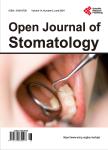Prevalence and Pattern Occurrence of Supernumerary Teeth in the North-East Heilongjiang Population of China
Prevalence and Pattern Occurrence of Supernumerary Teeth in the North-East Heilongjiang Population of China作者机构:Unit I Department of Oral and Maxillofacial Surgery Second Affiliated Hospital of Jiamusi University Jiamusi China Prosthodontics and Orthodontics Service Affiliated Hospital of Kinshasa University Kinshasa DR. Congo Unit of Periodontics Stomatology and Maxillofacial Service Affiliated Hospital of Kinshasa University Kinshasa DR. Congo Unit of Oral Surgery Stomatology and Maxillofacial Service Affiliated Hospital of Kinshasa University Kinshasa DR. Congo
出 版 物:《Open Journal of Stomatology》 (口腔学期刊(英文))
年 卷 期:2016年第6卷第2期
页 面:47-53页
主 题:Prevalence Occurrence Supernumerary Teeth Features
摘 要:Aims: The objective of the current research was to determine the prevalence of supernumerary teeth and investigate its characteristic and complications in the Chinese population from the North-East Heilongjiang region. Materials and Methods: It was a descriptive and retrospective study which used registered notes and panoramic radiographs of 12,984 patients who visited the Department of Oral and Maxillofacial Surgery in the 2nd Affiliated Hospital of Jiamusi University, China between June 2011 to November 2015. Patients diagnosed with any syndrome or hereditary diseases were excluded from the study. The features of supernumerary teeth were noted and the data were analyzed using SPSS program, (version 20, Inc., Chicago, USA). The Chi-square test was used to determine the differences in the distribution of supernumerary teeth. It was tested at the 5% level of significance. Results: The prevalence was 5.2% and the most prevalent supernumerary teeth was incisor with 3.39% (n = 441). The supernumerary teeth were seen more in maxilla than mandible. The male to female ratio was 2.9:1. Specifically, higher prevalence of supernumerary teeth in male gender was statistically significant (p = 0.03). The supernumerary teeth mostly occurred in children of 5 - 10 years (62.3%), followed by young adolescent between 11 - 16 years (26.5%). Conclusion: The prevalence of supernumerary teeth was widely seen in children and young adolescent of Chinese population. The occurrence was mostly seen in maxilla than mandible and significantly higher in male than female.



